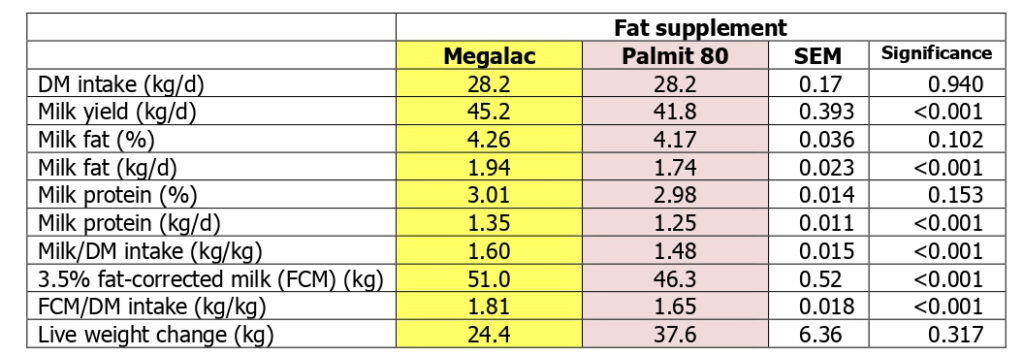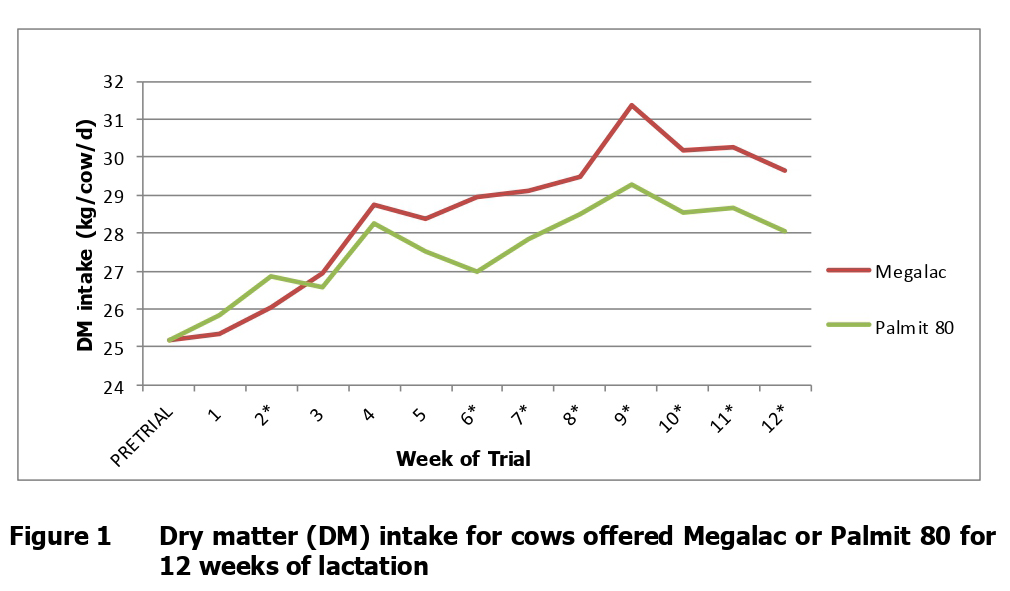
Production performance of dairy cows offered Megalac or a highC16 fat supplement
In Brief:
- Cows offered Megalac produced an additional 3.4 kg milk per day, an increase of 8.1%.
- Megalac-supplemented cows had similar DM intake.
- Cows offered Megalac produced milk almost 10% more efficiently.
- Beneficial effects of Megalac became much more apparent as feeding period increased.
Introduction:
Fat supplements are commonly added to rations for lactating dairy cows as an essential component to promote production, fertility and animal health. However, there are aconsiderable number of fat supplements available with almost all products having no research data available to support claims made.Megalac is the most highly-proven rumen-protected fat in the world with a wealth of research data having been produced over the past 30+ years to support all aspects of the product. High-C16 products are often used on farms but there are limited data available to support their effects, particularly when compared to Megalac.
Megalac vs high-C16 fat supplement
This bulletin summarizes findings from a recent study undertaken at the University of Delaware in the USA which compared the effect of supplementing dairy diets with either Megalac® or a ‘high-C16’ product, Palmit 80® (containing a high proportion of palmitic acid). The results were presented at the American Dairy Science Association Annual Conference, Indianapolis, July 2013.
Thirty early lactation dairy cows were allocated to one of two diets which differed only infat supplement offered :
1. Megalac rumen-protected fat
2. Palmit 80 – a ‘high-C16’ fat supplement
2. Palmit 80 – a ‘high-C16’ fat supplement
In Brief:


Fats were added on an equal fat basis at 1.2% on a dry matter (DM) basis for a 12-week period, corresponding to approximately 410 g of Megalac and 355 g of Palmit 80. Results from the study are presented in Table 1.
Table 1 Daily production parameters and body weight change over 12 weeks for cows offered Megalac or Palmit 80.

DM intake and milk yield
Total DM intake was very high during the study at over 28 kg/d and was similar between the two supplements. However, milk yield was a substantial 3.4 kg/d higher for the Megalac-fed cows compared to those offered the high-C16 supplement. This represents an increase in milk yield of over 8% achieved at similar DM intake.
Milk composition
Both milk fat % and milk protein % tended to be higher in cows fed Megalac but neither effect was statistically significant. However, yield of milk solids (kg/d) (both milk fat and milk protein) were considerably higher with cows offered Megalac compared to the highC16 supplement.
Feed efficiency
One of the key influencers on farm profitability is efficiency of production, assessed in terms of milk output per unit of feed input. Cows offered the Megalac supplement were considerably more efficient, producing higher milk yield and FCM per unit of DM intake than those offered the Palmit 80 supplement.
Milk production and DM intake were similar between the two groups of cows for
the first 5-6 weeks of supplementation.
the first 5-6 weeks of supplementation.

These differences highlight the importance of considering the longer-term effect of fat supplement on cow productivity and demonstrate that different fat supplement are used with different efficiencies in the dairy cow.
Feeding to reduce heat production
Digestion and metabolism of nutrients in ingested food is associated with the production of heat. This heat, termed the heat increment, is generated from a number of sources including the work associated with the digestion and mastication of food, the heat produced during ruminal fermentation, and the work of nutrient metabolism (inefficiencies in the conversion of nutrients to ATP). Hence, metabolisable energy (ME) contained within feeds is converted to the net energy used for maintenance of the animal, and that contained within animal products (e.g. milk, tissue, foetus) with an efficiency of less than 1.0, with the inefficiencies corresponding to metabolic heat production. Fibrous feeds result in larger increases in heat production than concentrate feeds due to factors including the greater work of digestion and increased activity of the highly metabolically-active liver. Similarly, diets yielding high levels of acetate are utilised lessefficiently than those resulting in higher levels of propionate.
How can Megalac help reduce heat stress ?
In contrast to other nutrients, dietary fat undergoes minimal fermentation in the rumen and is used with much greater efficiency (i.e. lower heat production). Research work has determined the net energy value of lactation (NEL) of Megalac to be 27.3 MJ/kg DM based on in vivo studies with dairy cows. This indicates that ME in Megalac is converted to NEL with similar efficiency to that generally accepted for utilisation of mobilised body energy in lactating cows (0.82). This is substantially above the mean efficiency of use of common diets (0.64), such that heat production associated with digestion and metabolism of Megalac is considerably less than with other dietary ingredients. The high ME of Megalac (33.3 MJ/kg DM) also enables high energy density diets to be formulated to help ensure energy supply is increased even when total DM intake is low, thereby helping to improve the energy status of the animal. Furthermore, as a rumenprotected fat, Megalac does not add to the acid load in the rumen so is a ‘safe’ ingredient under heat stress conditions where acidosis is a particular risk.

These data suggest that reformulation of diets to incorporate Megalac is an important method of increasing energy intake under heat stress conditions, while also reducing the metabolic heat load imposed on the animal due to its properties as a ‘cool’ ingredient.
Summary
- Megalac cows produced 3.4 kg/d more milk, at similar DM intake, to cows offered a
high-C16 supplement. - Cows offered Megalac produced milk almost 10% more efficiently.
- Megalac-supplemented cows produced 8.1% more milk, with higher milk solids, while
continuing to gain weight through early lactation. - It is vital to consider the effects of fat supplementation on a longer-term basis rather
than short-term. The beneficial effects of Megalac on production performance become
much more evident with longer feeding periods which will have major effects on
profitability






